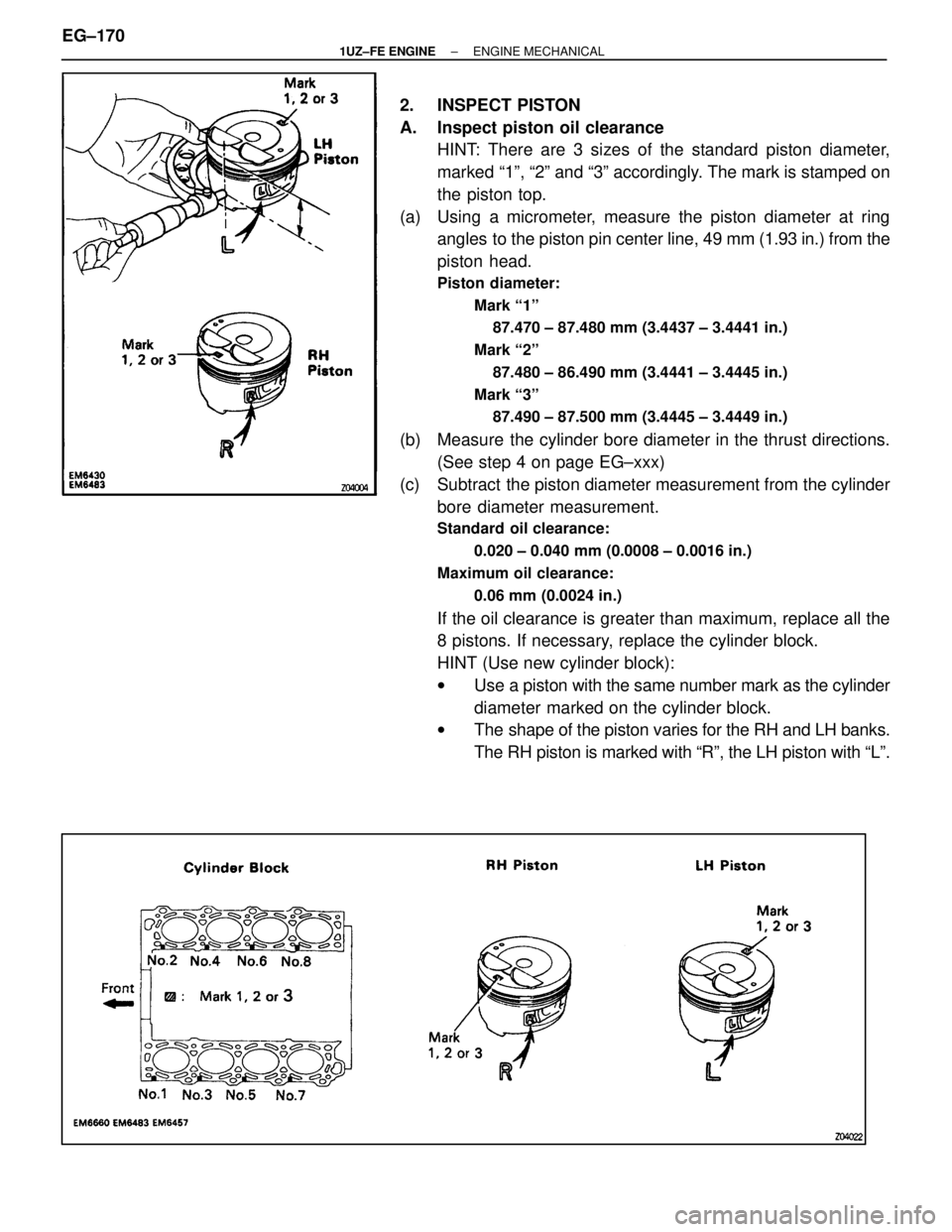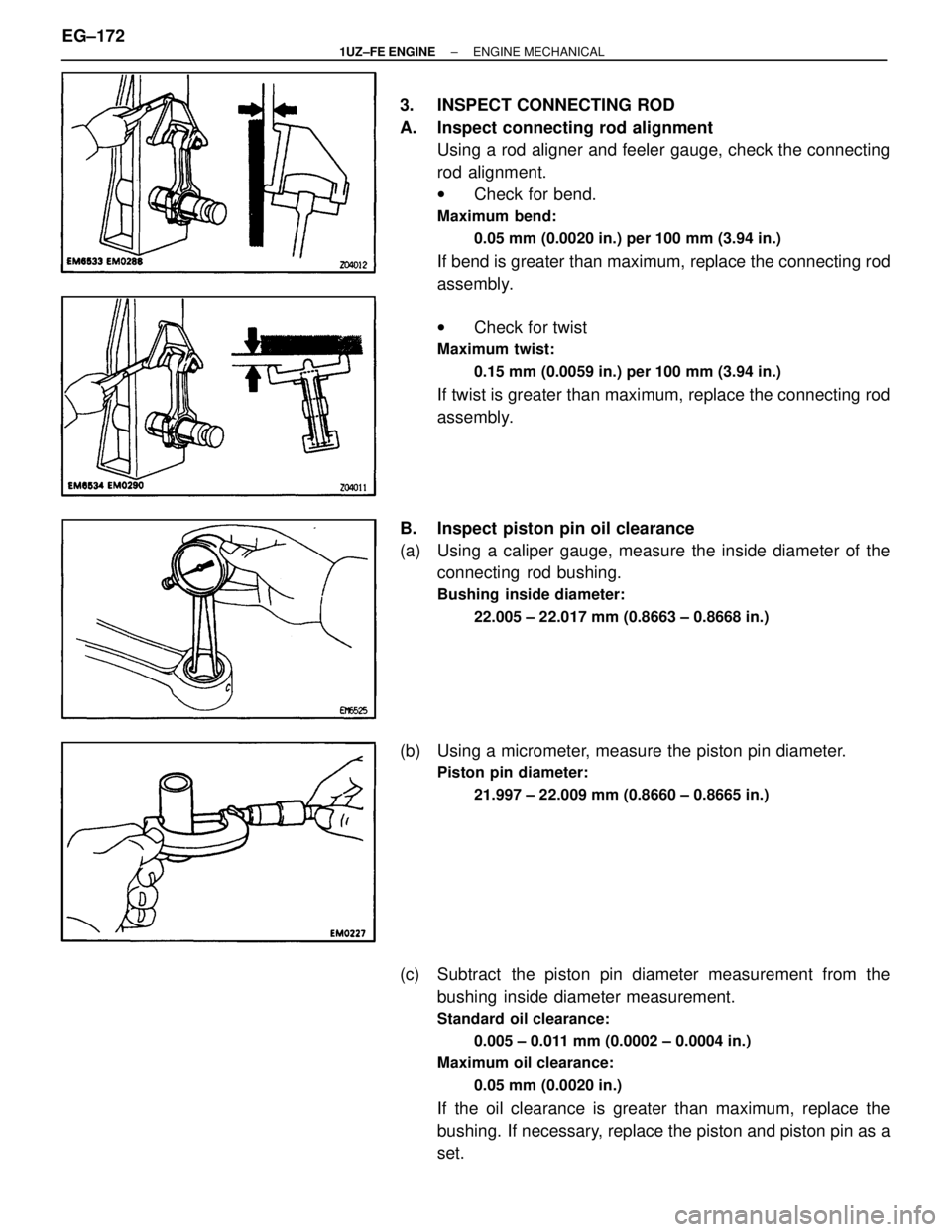Page 1544 of 4087
(b) Remove the 2 side rails and oil ring by hand.HINT: Arrange the piston rings in correct order only.
3. DISCONNECT CONNECTING ROD FROM PISTON
(a) Using a small screwdriver, pry out the 2 snap rings.
(b) Gradually heat the piston to approx. 60 �C (140 �F).
(c) Using a plastic±faced hammer and brass bar, lightly tap out the piston pin and pin and remove the connecting rod.
EG±168
±
1UZ±FE ENGINE ENGINE MECHANICAL
WhereEverybodyKnowsYourName
Page 1545 of 4087
HINT:
wThe piston and pin are a matched set.
w Arrange the pistons, pins, rings, connecting rods and
bearings in correct order.
PISTON AND CONNECTING ROD
INSPECTION
EG1KY±02
1. CLEAN PISTON
(a) Using a gasket scraper, remove the carbon from the piston
top.
(b) Using a groove cleaning tool or broken ring, clean the piston ring grooves.
(c) Using solvent and a brush, thoroughly clean the piston.
NOTICE: Do not use a wire brush.
±
1UZ±FE ENGINE ENGINE MECHANICALEG±169
WhereEverybodyKnowsYourName
Page 1546 of 4087

2. INSPECT PISTON
A. Inspect piston oil clearanceHINT: There are 3 sizes of the standard piston diameter,
marked ª1º, ª2º and ª3º accordingly. The mark is stamped on
the piston top.
(a) Using a micrometer, measure the piston diameter at ring angles to the piston pin center line, 49 mm (1.93 in.) f rom the
piston head.
Piston diameter:
Mark ª1º87.470 ± 87.480 mm (3.4437 ± 3.4441 in.)
Mark ª2º 87.480 ± 86.490 mm (3.4441 ± 3.4445 in.)
Mark ª3º 87.490 ± 87.500 mm (3.4445 ± 3.4449 in.)
(b) Measure the cylinder bore diameter in the thrust directions. (See step 4 on page EG±xxx)
(c) Subtract the piston diameter measurement from the cylinder bore diameter measurement.
Standard oil clearance:
0.020 ± 0.040 mm (0.0008 ± 0.0016 in.)
Maximum oil clearance: 0.06 mm (0.0024 in.)
If the oil clearance is greater than maximum, replace all the
8 pistons. If necessary, replace the cylinder block.
HINT (Use new cylinder block):
wUse a piston with the same number mark as the cylinder
diameter marked on the cylinder block.
w The shape of the piston varies for the RH and LH banks.
The RH piston is marked with ªRº, the LH piston with ªLº.
EG±170±
1UZ±FE ENGINE ENGINE MECHANICAL
WhereEverybodyKnowsYourName
Page 1547 of 4087

B. Inspect piston ring groove clearanceUsing a feeler gauge, measure the clearance between new
piston ring and the wall of the ring groove
Ring groove clearance:
No.10.020 ± 0.060 mm (0.0008 ± 0.0024 in.)
No.2
0.015 ± 0.055 mm (0.0006 ± 0.0022 in.)
If the clearance is not as specified, replace the piston.
C. Inspect piston ring and gap
(a) Insert the piston ring into the cylinder bore.
(b) Using a piston, push the piston ring a little beyond the bottom
of the ring travel, 105 mm (4.13 in.) from the top of the cylinder
block.
(c) Using a feeler gauge, measure the end gap.
Standard end gap: No.10.250 ± 0.450 mm (0.0098 ± 0.0177 in.)
No.2 0.350 ± 0.600 mm (0.0138 ± 0.0236 in.)
Oil (Side rail)
0.160 ± 0.500 mm (0.0059 ± 0.0197 in.)
Maximum end gap: No.11.05 mm (0.0413 in.)
No.2 1.20 mm (0.0472 in.)
Oil (Side rail) 1.10 mm (0.0433 in.)
If the end gap is greater than maximum, replace the piston
ring. If the end gap is greater than maximum, even with a new
piston ring, replace the cylinder block.
D. Inspect piston pin fit At 60 5C (140 5F), you should be able to push the piston pin
into the piston pin hole with your thumb.
±
1UZ±FE ENGINE ENGINE MECHANICALEG±171
WhereEverybodyKnowsYourName
Page 1548 of 4087

3. INSPECT CONNECTING ROD
A. Inspect connecting rod alignmentUsing a rod aligner and feeler gauge, check the connecting
rod alignment.
wCheck for bend.
Maximum bend:
0.05 mm (0.0020 in.) per 100 mm (3.94 in.)
If bend is greater than maximum, replace the connecting rod
assembly.
wCheck for twist
Maximum twist:
0.15 mm (0.0059 in.) per 100 mm (3.94 in.)
If twist is greater than maximum, replace the connecting rod
assembly.
B. Inspect piston pin oil clearance
(a) Using a caliper gauge, measure the inside diameter of the connecting rod bushing.
Bushing inside diameter:
22.005 ± 22.017 mm (0.8663 ± 0.8668 in.)
(b) Using a micrometer, measure the piston pin diameter.
Piston pin diameter:21.997 ± 22.009 mm (0.8660 ± 0.8665 in.)
(c) Subtract the piston pin diameter measurement from thebushing inside diameter measurement.
Standard oil clearance:
0.005 ± 0.011 mm (0.0002 ± 0.0004 in.)
Maximum oil clearance: 0.05 mm (0.0020 in.)
If the oil clearance is greater than maximum, replace the
bushing. If necessary, replace the piston and piston pin as a
set.
EG±172
±
1UZ±FE ENGINE ENGINE MECHANICAL
WhereEverybodyKnowsYourName
Page 1549 of 4087
C. If necessary, replace connecting rod bushing
(a) Using SST and a press, press out the bushing.SST 09222±30010
(b) Align the oil holes of a new bushing and the connecting rod.
(c) Using SST and a press, press out the bushing SST 09222±30010
(d) Using a pin hole grinder, hone the bushing to obtain the standard specified clearance (see step B above) between
the bushing and piston pin.
(e) Check the piston pin fit at normal room temperature. Coat the piston pin with engine oil, and push it into the con-
necting rod with your thumb.
D. Inspect connecting rod bolts Using a vernier caliper, measure the tension portion of of the
connecting rod bolt.
Standard diameter:
7.200 ± 7.300 mm (0.2835 ± 0.2874 in.)
Maximum diameter: 7.00 mm (0.2756 in.)
HINT: If the tension portion diameter is less than minimum,
replace the connecting rod bolt.
±
1UZ±FE ENGINE ENGINE MECHANICALEG±173
WhereEverybodyKnowsYourName
Page 1550 of 4087
CRANKSHAFT INSPECTION
EG0BY±0D
1. INSPECT CRANKSHAFT FOR CIRCLE RUNOUT
(a) Place the crankshaft on V±blocks.
(b) Using a dial indicator, measure the circle runout at the centerjournal.
Maximum circle runout:
0.08 mm (0.0031 in.)
If the circle runout is greater than maximum, replace the
crankshaft.
2. INSPECT MAIN JOURNALS AND CRANK PINS
(a) Using a micrometer, measure the diameter of each main journal and crank pin.
Main journal diameter:
66.988 ± 67.000 mm (2.6373 ± 2.6378 in.)
Crank pin diameter: 51.982 ± 52.000 mm (2.0465 ± 2.0472 in.)
If the diameter is not as specified, check the oil clearance
(See steps 3 or 6 on page EG±156 or 160). If necessary, re-
place the crankshaft.
(b) Ch e ck ea ch ma in jo u rn a l an d cra n k pin fo r t aper and
out±of±round as shown.
Maximum taper and out±of±round:
0.02 mm (0.0008 in.)
If the taper and out±of±round is greater than maximum, re-
place the crankshaft.
EG±174
±
1UZ±FE ENGINE ENGINE MECHANICAL
WhereEverybodyKnowsYourName
Page 1551 of 4087
CRANKSHAFT OIL SEALS
REPLACEMENT
EG0C0±0M
HINT: There are 2 methods (A and B) to replace the oil seal
which are as follows:
1. REPLACE CRANKSHAFT FRONT OIL SEAL
A. If oil pump is removed from cylinder block:
(a) Using a screwdriver, pry out the oil seal.
(b) Using SST and a hammer, tap in a new oil seal until its surface
is flush with the oil pump body edge.
SST 09316±60010 (09316±00010)
(c) Apply MP grease to the oil seal lip.
B. If oil pump is installed to the cylinder block:
(a) Using a knife, cut off the oil seal lip.
(b) Using a screwdriver, pry out the oil seal. NOTICE: Be careful not to damage the crankshaft. Tape
the screwdriver tip.
(c) Apply MP grease to a new oil seal lip.
(d) Using SST and a hammer, tap in the oil seal until its surface is flush with the oil pump body edge.
SST 09316±60010 (09316±00010)
±
1UZ±FE ENGINE ENGINE MECHANICALEG±175
WhereEverybodyKnowsYourName